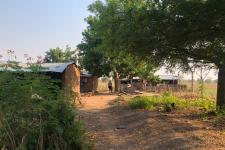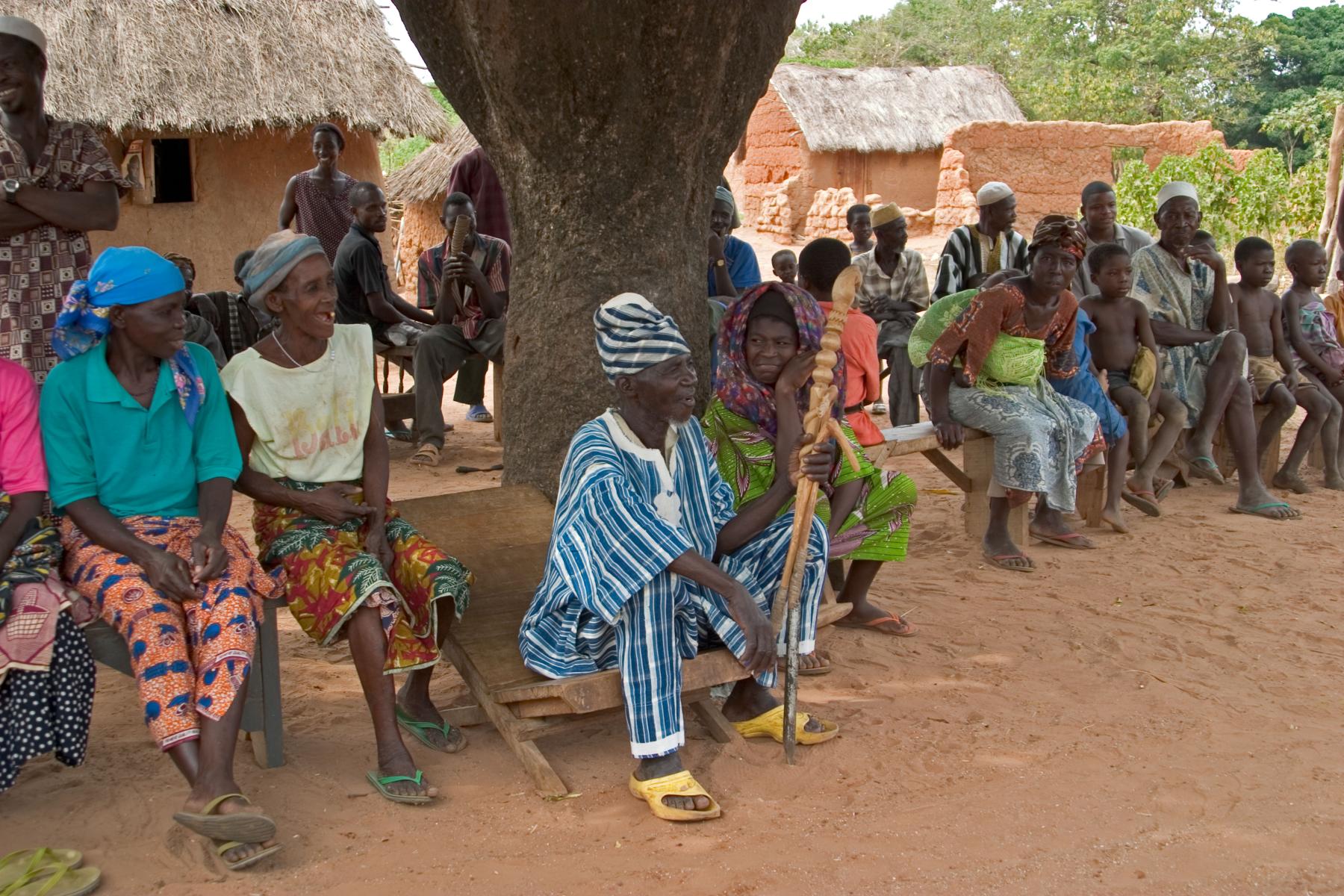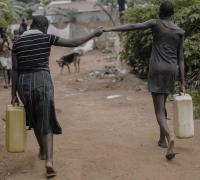What Loss and Damage has to offer

The decision on a new Loss and Damage Fund at COP28 helps establish Loss and Damage as a major field within the international climate response – but how can that translate to improved support on the ground? Research findings indicate Loss and Damage can provide new approaches and attention to overlooked climate impacts.
Devastation and displacement on the ground
When our research team first approached the village, they were sent packing. ‘You come here, to our destroyed houses, with no help, and want to ask us questions?’, one man accused.
The village, in the Upper West Region of Northern Ghana, had again experienced floods and devastation, with some residents experiencing short-term displacement.
Over several years of research into climate-related mobility we have observed a worrying increase in these small-scale extreme events. They have been occurring under the radar, garnering little attention or subsequent support.
In a setting where people were already struggling with poverty and slow-onset climate change, some doing their best just to feed their families, their frustration was palpable.
Further towards the Sahel in Niger, the Red Cross country team has also been confronting repeated displacements, here closely linked to insecurity and conflict as well as climate change.
The two settings are quite different – in their governance and histories, their peoples and customs, and the ways in which people moved, including the factors at play. But increasingly emerging in both countries is a critical element of loss and damage linked to climate change and displacement – erosion of the social cohesion among or across communities.
Social cohesion refers to the social fabric that is of critical importance for communities’ ability to thrive. The strain we are observing on social cohesion, and the implications for communities that are already struggling, is a troubling development in climate impacts.
This prompted a collaborative initiative between researchers and Red Cross staff and volunteers across Ghana, Niger and Denmark to investigate linkages between climate-related displacement and loss and damage – as well as possible responses.
Social cohesion under strain
Attention to social cohesion has been increasing over the last few years, especially among international organizations, particularly the World Bank. But focus has especially been on conflict situations and relations between displaced or refugee populations and the communities that host them.
Now, we are seeing something new, where even repeated, localized displacement around one homogenous community is straining social cohesion. In societies under pressure from poverty and climate change, and where social relations and mutual support were the primary safety net, this was a dangerous development.
This strain on social cohesion also emerged in a long term research program we have been conducting in Ghana and Ethiopia. In Northern Ghana, we could see that even proactive climate-related migration, where community members abandoned risky and low-yield local farming to seek economic opportunities elsewhere, were in some ways straining social relations in their home villages.
It was becoming clear that social cohesion was not just an issue in settings of displacement and conflict – but also clearly emerging around many other forms of climate-related mobility. As climate change intensifies, this trend will likely worsen.
Making Loss and Damage history at COP27 and COP28
These developments on the ground have been paralleled by the rapidly shifting international policy context – the new international architecture of Loss and Damage finance and technical assistance.
Recent climate change COP meetings have been praised for making history on Loss and Damage, an area of international climate response that deals with ‘averting, minimizing and addressing the adverse effects of climate change’ as stated in the Paris Agreement.
While mitigation aims to reduce greenhouse gasses in the atmosphere, and adaptation aims to proactively manage emerging climate impacts, Loss and Damage is targeted at addressing the negative impacts of climate change after the fact – picking up the pieces after events like the catastrophic floods in Pakistan last year and ongoing drought in the Horn of Africa.
At COP27 in Egypt last year, parties agreed to establish finance for Loss and Damage, long pushed for by developing countries facing the brunt of climate change. At COP28 this year, parties have operationalized this, partly through a new Loss and Damage Fund.
These decisions come on the heels of the establishment of technical assistance for Loss and Damage through the Santiago Network. Together they help establish a new sphere of international climate response.
Expectations for this new sphere are many, and at times diverging. Early financial pledges provide a start, but pale beside the hundreds of billions estimated to be needed annually to address losses and damages already now.
Climate mobility, social cohesion and loss and damage
The Fund also faces the challenge of encompassing the diversity of negative climate impacts. Loss and Damage in international policy has always been an umbrella for many different things – including measurable economic losses as well as non-economic losses such as loss of loved ones, health, or local knowledge.
One type of non-economic loss is climate-related mobility, like the climate-related displacement we are witnessing in Ghana and Niger. While mobility can bring opportunities and benefits, it can also be challenging, even dangerous, and create strain on families and communities – sometimes all at once.
Social cohesion has also been recognized within Loss and Damage, but relatively narrowly – for instance people losing cultural heritage when long-standing and culturally important community practices are lost, or losing valuable indigenous or local knowledge.
Yet our initial findings indicate that social cohesion is a much broader issue within climate-related loss and damage than previously recognized.
This echoes other recent findings. Climate change impacts have been eroding communities’ support structures and social relations around the world – from breakdowns in communal food- and labor-sharing arrangements to shifts in community and family relations as individuals migrate for new opportunities.
While there have been examples of positive social cohesion impacts in relation to climate change – as communities rally together after a storm or flood – these seem less common.
So even as policymakers and stakeholders hail historic finance arrangements for Loss and Damage, communities are struggling under the weight of multiple dimensions of losses and damages simultaneously: Losses to yields and livelihoods, environmental degradation and biodiversity loss, climate-related mobility – and increasingly loss of the fundamental social fabric of communities themselves.
International response: Supporting coherence and access
What, then, can the emerging international Loss and Damage architecture offer – for instance to a family with a flooded house and increasingly precarious existence?
In the text on the operationalization of the new Loss and Damage funding arrangement and fund from COP28, a few aspects stand out.
For one, the new architecture aims to increase coherence across existing approaches and actors. In our research, we can see that existing responses and knowledge in different fields can be brought together in new ways to help address losses and damages – in our case in relation to social cohesion.
In the contexts of conflict and disasters, many humanitarian organizations are already offering forms of psychosocial support that are also relevant for addressing loss of social cohesion in other climate-affected contexts.
In relation to conflict and displacement, there has been growing attention to how social cohesion in areas hosting displaced persons can be improved through interventions – from social protection to service delivery.
These experiences across fields can be combined to address the broader social cohesion challenges that are emerging due to climate impacts. And the new institutional architecture for Loss and Damage can play a key role in bringing these together.
In addition, the new finance arrangements emphasize engagement with sub-national entities and affected populations, for instance through ‘direct access’ to funding.
Locally-led action has also been a learning from adaptation efforts. It is perhaps even more clearly a necessity for loss and damage which is both highly context-based and value-based. This point of departure is crucial for successful interventions, and dovetails with findings of the importance bottom-up inclusion of affected populations for outcomes.
Building in-country capacity
The new international Loss and Damage institutions also, on paper, seek to offer predictable funding as well as support for developing programming and in-country capacities.
Together, these have the potential to prompt ripple effects among the countries and organizations responding to climate change impacts, driving new policy, programming and practice on Loss and Damage, with potentially wide-ranging effects.
For least developed countries especially, developing institutional capacities for loss and damage is one among many overlapping demands on limited time and resources. Dedicated, predictable funding – if this is achieved – as well as institutional and technical support will better allow countries to prioritize Loss and Damage domestically and build up necessary in-country capacities.
However, concerns and uncertainties remain. The significance of the Loss and Damage Fund especially is being debated. The fund will surely only be able to provide limited funding in the face of massive need, and many aspects of its focus and approach are left to be determined.
But there are promising aspects of the recent Loss and Damage decisions that can offer important contributions in an emerging field of intervention – if harnessed successfully.
This will require a concerted effort by relevant organizations, affected countries, and – especially in the new Loss and Damage Fund – the coming Board, to shape this new institutional architecture to respond to diverse needs on the ground.
Losses on the ground
Even as actors and organizations rush to translate the aspirations of the new Loss and Damage finance and institutions into action, losses on the ground are building.
In the flooded village our team visited in Northern Ghana, the future is uncertain. But repeated visits and engagement from our team has helped build rapport and trust, creating spaces for residents to share deepfelt concerns.
People are worried about their ability to support their families, see their communities thrive, and envision positive futures for themselves.
While we have not been able to offer material support in the face of destroyed homes and crops, we have committed to tell their story, sharing their experiences and perspectives with those making policies and programs, and those implementing – those who need to hear their thoughts and needs.
And, perhaps soon, there will be new avenues to help address the losses and challenges they face from the flooded ruins of their homes.
DIIS Experts



